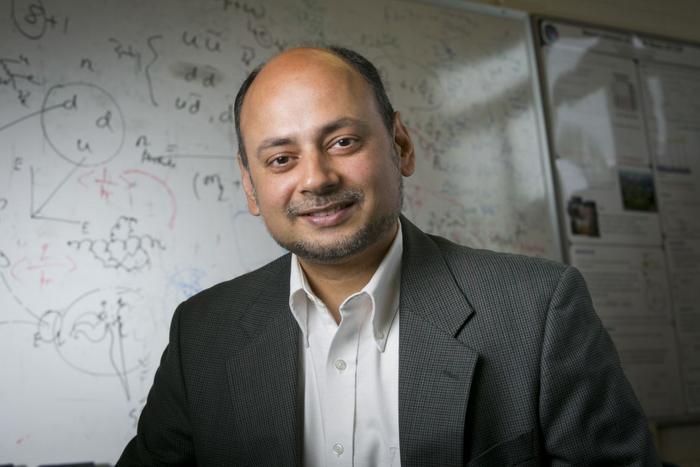DURHAM, N.C. — It sounds fantastical, but it’s a reality for the scientists who work at the world’s largest particle collider:

Credit: Duke University
DURHAM, N.C. — It sounds fantastical, but it’s a reality for the scientists who work at the world’s largest particle collider:
In an underground tunnel some 350 feet beneath the France–Switzerland border, a huge device called the Large Hadron Collider sends beams of protons smashing into each other at nearly the speed of light, creating tiny eruptions that mimic the conditions that existed immediately after the Big Bang.
Scientists like Duke physicist Ashutosh Kotwal think the subatomic debris of these collisions could contain hints of the universe’s “missing matter.” And with some help from artificial intelligence, Kotwal hopes to catch these fleeting clues on camera, using a design described May 3 in the journal Scientific Reports.
Ordinary matter — the stuff of people and planets — is only part of what’s out there. Kotwal and others are hunting for dark matter, an invisible matter that’s five times more abundant than the stuff we can see but whose nature remains a mystery.
Scientists know it exists from its gravitational influence on stars and galaxies, but other than that we don’t know much about it.
The Large Hadron Collider could change that. There, researchers are looking for dark matter and other mysteries using detectors that act like giant 3D digital cameras, taking continuous snapshots of the spray of particles produced by each proton-proton collision.
Only ordinary particles trigger a detector’s sensors. If researchers can make dark matter at the LHC, scientists think one way it could be noticeable is as a sort of disappearing act: heavy charged particles that travel a certain distance — 10 inches or so — from the point of collision and then decay invisibly into dark matter particles without leaving a trace.
If you retraced the paths of these particles, they would leave a telltale “disappearing track” that vanishes partway through the detector’s inner layers.
But to spot these elusive tracks they’ll need to act fast, Kotwal says.
That’s because the LHC’s detectors take some 40 million snapshots of flying particles every second.
That’s too much raw data to hang on to everything and most of it isn’t very interesting. Kotwal is looking for a needle in a haystack.
“Most of these images don’t have the special signatures we’re looking for,” Kotwal said. “Maybe one in a million is one that we want to save.”
Researchers have just a few millionths of a second to determine if a particular collision is of interest and store it for later analysis.
“To do that in real time, and for months on end, would require an image recognition technique that can run at least 100 times faster than anything particle physicists have ever been able to do,” Kotwal said.
Kotwal thinks he may have a solution. He has been developing something called a “track trigger,” a fast algorithm that is able to spot and flag these fleeting tracks before the next collision occurs, and from among a cloud of tens of thousands of other data points measured at the same time.
His design works by divvying up the task of analyzing each image among a large number of AI engines running simultaneously, built directly onto a silicon chip. The method processes an image in less than 250 nanoseconds, automatically weeding out the uninteresting ones.
Kotwal first described the approach in a sequence of two papers published in 2020 and 2021. In the more recent paper published this May in Scientific Reports, he and a team of undergraduate student co-authors show that his algorithm can run on a silicon chip.
Kotwal and his students plan to build a prototype of their device by next summer, though it will be another three or four years before the full device — which will consist of about 2000 chips — can be installed at detectors at the LHC.
As the performance of the accelerator continues to crank up, it will produce even more particles. And Kotwal’s device could help make sure that, if dark matter is hiding among them, scientists won’t miss it.
“Our job is to ensure that if dark matter production is happening, then our technology is up to snuff to catch it in the act,” Kotwal said.
Journal
Scientific Reports
Method of Research
Computational simulation/modeling
Subject of Research
Not applicable
Article Title
A low-latency graph computer to identify metastable particles at the Large Hadron Collider for real-time analysis of potential dark matter signatures
Article Publication Date
3-May-2024



